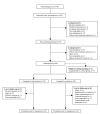The effect of a pedometer-based community walking intervention "Walking for Wellbeing in the West" on physical activity levels and health outcomes: a 12-week randomized controlled trial
- PMID: 18775062
- PMCID: PMC2546435
- DOI: 10.1186/1479-5868-5-44
The effect of a pedometer-based community walking intervention "Walking for Wellbeing in the West" on physical activity levels and health outcomes: a 12-week randomized controlled trial
Erratum in
-
The effect of a pedometer-based community walking intervention "Walking for Wellbeing in the West" on physical activity levels and health outcomes: a 12-week randomized controlled trial.Int J Behav Nutr Phys Act. 2010 May 27;7:51. doi: 10.1186/1479-5868-7-51. Int J Behav Nutr Phys Act. 2010. PMID: 20507592 Free PMC article. No abstract available.
Abstract
Background: Recent systematic reviews have suggested that pedometers may be effective motivational tools to promote walking. However, studies tend to be of a relatively short duration, with small clinical based samples. Further research is required to demonstrate their effectiveness in adequately powered, community based studies.
Objective: Using a randomized controlled trial design, this study assessed the impact of a 12-week graduated pedometer-based walking intervention on daily step-counts, self-reported physical activity and health outcomes in a Scottish community sample not meeting current physical activity recommendations.
Method: Sixty-three women and 16 men (49.2 years +/- 8.8) were randomly assigned to either an intervention (physical activity consultation and 12-week pedometer-based walking program) or control (no action) group. Measures for step-counts, 7-day physical activity recall, affect, quality of life (n = 79), body mass, BMI, % body fat, waist and hip circumference (n = 76), systolic/diastolic blood pressure, total cholesterol and HDL cholesterol (n = 66) were taken at baseline and week 12. Analyses were performed on an intention to treat basis using 2-way mixed factorial analyses of variance for parametric data and Mann Whitney and Wilcoxon tests for non-parametric data.
Results: Significant increases were found in the intervention group for step-counts (p < .001), time spent in leisure walking (p = .02) and positive affect (p = .027). Significant decreases were found in this group for time spent in weekday (p = .003), weekend (p = .001) and total sitting (p = .001) with no corresponding changes in the control group. No significant changes in any other health outcomes were found in either group. In comparison with the control group at week 12, the intervention group reported a significantly greater number of minutes spent in leisure time (p = .008), occupational (p = .045) and total walking (p = .03), and significantly fewer minutes in time spent in weekend (p = .003) and total sitting (p = .022).
Conclusion: A pedometer-based walking program, incorporating a physical activity consultation, is effective in promoting walking and improving positive affect over 12 weeks in community based individuals. The discussion examines possible explanations for the lack of significant changes in health outcomes. Continued follow-up of this study will examine adherence to the intervention and possible resulting effects on health outcomes.
Figures
References
-
- Haskell WL, Lee IM, Pate RR, Powell KE, Blair SN, Franklin BA, Macera CA, Heath GW, Thompson PD, Bauman A, et al. Physical activity and public health: updated recommendation for adults from the American College of Sports Medicine and the American Heart Association. Circulation. 2007;116:1081–1093. doi: 10.1161/CIRCULATIONAHA.107.185649. - DOI - PubMed
-
- Nelson ME, Rejeski WJ, Blair SN, Duncan PW, Judge JO, King AC, Macera CA, Castaneda-Sceppa C, American College of Sports M, American Heart A Physical activity and public health in older adults: recommendation from the American College of Sports Medicine and the American Heart Association. Circulation. 2007;116:1094–1105. doi: 10.1161/CIRCULATIONAHA.107.185650. - DOI - PubMed
-
- Scottish Executive . The Scottish Health Survey 2003. Edinburgh: Crown Copyright; 2005.
Grants and funding
LinkOut - more resources
Full Text Sources



